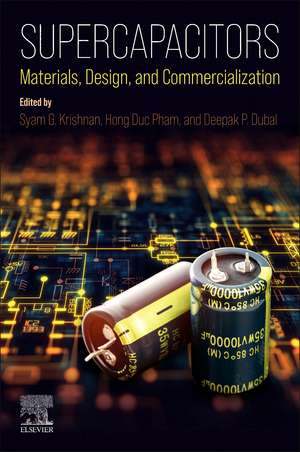Supercapacitors: Materials, Design, and Commercialization
Editat de Syam G. Krishnan, Hong Duc Pham, Deepak P. Dubalen Limba Engleză Paperback – 20 mar 2024
This is followed by in-depth coverage of electrolytes, including the evolution of electrolytes from aqueous to water-in-salt electrolytes and their role in improving the energy density of supercapacitors. The final part of the book examines the role of artificial intelligence in the design of supercapacitors, and latest developments in translating novel supercapacitor technologies from laboratory-scale research to a commercialization.
- Brings together the latest developments in supercapacitor materials and electrolytes
- Discusses cutting-edge charge storage concepts and methods for supercapacitors
- Addresses the role of machine learning and the scale-up from laboratory to commercialization
Preț: 805.97 lei
Preț vechi: 1053.68 lei
-24% Nou
Puncte Express: 1209
Preț estimativ în valută:
154.24€ • 160.44$ • 127.34£
154.24€ • 160.44$ • 127.34£
Carte tipărită la comandă
Livrare economică 07-21 aprilie
Livrare express 07-13 martie pentru 97.48 lei
Preluare comenzi: 021 569.72.76
Specificații
ISBN-13: 9780443154782
ISBN-10: 0443154783
Pagini: 434
Dimensiuni: 152 x 229 x 24 mm
Greutate: 0.7 kg
Editura: ELSEVIER SCIENCE
ISBN-10: 0443154783
Pagini: 434
Dimensiuni: 152 x 229 x 24 mm
Greutate: 0.7 kg
Editura: ELSEVIER SCIENCE
Cuprins
1. Introduction to supercapacitors, materials, and design
2. Nanocarbons and Electric Double Layer Capacitors (EDLC)
3. Categories of Pseudocapacitors: Intrinsic, extrinsic, and intercalation materials
4. Electrochemical characterization and calculation methods of supercapacitors
5. Transition metal oxides/sulfides electrode-based supercapacitors
6. Conducting polymers and their composites as supercapacitor electrodes
7. MOF and their derivatives for supercapacitors
8. Supercapacitors based on MXene (carbides/nitrides) and black phosphorous electrodes
9. Polyoxometalates (POMs) and redox active molecular clusters for supercapacitors
10. Conventional Supercapacitor electrolytes: Aqueous, Organic, and Ionic
11. Solid-state and gel-type supercapacitor electrolytes – polymers and cross-linkers
12. Water-in-salt electrolyte – towards high voltage aqueous supercapacitors
13. Deep eutectic solvents as green and cheap supercapacitor electrolytes
14. Device configuration: Asymmetric vs. hybrid supercapacitors
15. Machine learning and data-driven materials exploration for supercapacitors
16. Translation of supercapacitor technology from laboratory scale to commercialization
2. Nanocarbons and Electric Double Layer Capacitors (EDLC)
3. Categories of Pseudocapacitors: Intrinsic, extrinsic, and intercalation materials
4. Electrochemical characterization and calculation methods of supercapacitors
5. Transition metal oxides/sulfides electrode-based supercapacitors
6. Conducting polymers and their composites as supercapacitor electrodes
7. MOF and their derivatives for supercapacitors
8. Supercapacitors based on MXene (carbides/nitrides) and black phosphorous electrodes
9. Polyoxometalates (POMs) and redox active molecular clusters for supercapacitors
10. Conventional Supercapacitor electrolytes: Aqueous, Organic, and Ionic
11. Solid-state and gel-type supercapacitor electrolytes – polymers and cross-linkers
12. Water-in-salt electrolyte – towards high voltage aqueous supercapacitors
13. Deep eutectic solvents as green and cheap supercapacitor electrolytes
14. Device configuration: Asymmetric vs. hybrid supercapacitors
15. Machine learning and data-driven materials exploration for supercapacitors
16. Translation of supercapacitor technology from laboratory scale to commercialization
